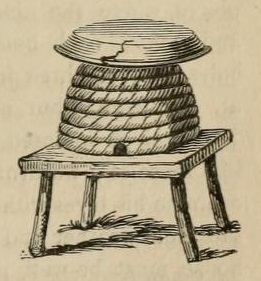
Fitzwilliam Museum, Cambridge
There’s something sinister about the tangled, prickly stems framing William Blake’s illustration for his song, The Sick Rose. The large, crimson flowered rose is no longer upright; it has collapsed, its beautiful head now lying on the ground, alerting us that all is not well in the garden.
At the top of the image, where we might expect a healthy rose to appear, is the arched, segmented body of a caterpillar. Its shape seems to mimic the pattern of the prickly rose stem just behind it; perhaps a natural camouflage device offering some protection from predatory birds, or a gardener seeking to remove it before more damage is done.
Sometimes called the ‘worm i’ the bud’, a moth larvae was once well known for attacking rose buds and hollowing them out from the inside, spoiling the flowers. The florist, Thomas Hogg, writing in 1822 observes that rose buds, ‘are very often destroyed in the spring by a small dark red grub, which feeds upon them, folds itself up in the leaves, and then changes into a moth chrysalis;’. John Fraser, who managed a plant nursery in Lea Bridge Road, East London in the mid-19th century, refers to a caterpillar which attacks the rose shoots as soon as they begins to grow and suggests picking the pests off by hand.
It’s unclear exactly when this troublesome caterpillar disappeared from the English garden, and unlikely that it was mourned by gardeners – but its loss is an indicator of the gradual decline in biodiversity. It would also explain why we no longer know much about this moth, which is not mentioned in today’s gardening literature.
Used as a metaphor for sexual violence in The Sick Rose, the relationship between the rose and the caterpillar is echoed in popular songs from the late eighteenth century. Published by Joseph Ritson, A Select Collection of English Songs (1783) contains songs where women are symbolised by the rose, and where the interaction between a rose and an insect is sexualised.
In one of these songs, adapted from a Spanish madrigal by Mr Garrick, a bee is attracted away from a damask rose by the sweetness of a young woman named Louisa, and leaves his sting in her lip. This verse from another song, by Sir William Yonge explores a similar theme:
‘With wanton flight the curious bee
From flow’r to flow’r still wanders free;
And where each blossom blows,
Extracts the juice of all he meets,
But, for his quintessence of sweets
He ravishes the rose.’
By replacing the bee with a caterpillar, in The Sick Rose, a creature people were far less well disposed towards, the attack on the rose seems more shocking. Instead of flying by day, like the bee, the moth flies unseen by night, suggesting danger. As the tiny eggs laid on the rose bud hatch, they will eventually cause its destruction.
Joseph Ritson (1752 – 1803) was a significant figure in the life of William Blake. A publisher who employed Blake as a commercial artist, Ritson produced compilations of English and Scottish songs, poetry, literature, fairy tales and nursery rhymes; all subjects that interested and inspired Blake.
A Select Collection of English Songs appeared in three volumes; the first is a compilation of love songs, the second a collection of drinking songs and other miscellaneous songs and ballads, while the third contains musical notation for the songs. Blake provided several engravings for this book, taken from a series of paintings by James Stodhart.
In the light of Blake’s involvement with Ritson’s song collection, it seems evident that Blake has drawn inspiration from the songs it contains. Throughout his Songs of Innocence and Experience, Blake uses the conventional forms of these popular lyrics, but adjusts the content, reflecting his own unconventional viewpoint.

A Select Collection of English Songs Vol 1
Engraving by William Blake after Stothard

A Select Collection of English Songs Vol 1
Engraving by William Blake after Stothard

A Select Collection of English Songs Vol 1
Disdain returned

A Select Collection of English Songs Vol 2
(engraving – Heath)
Blake’s image of The Sick Rose is highly stylised, and not really possible to identify as a particular species or variety, but we know that at the end of the 18th century, the range of roses grown in England was a fraction of those available today. In Roses, or, A monograph of the genus Rosa (1805), the author Henry Charles Andrews estimates ‘within a hundred’ varieties were cultivated. In his book, sixty are illustrated, observed in his friends’ gardens as well as at leading nurseries in Chelsea, and at Loddiges in Hackney. I’ve included some of the roses from Andrews’ monograph that have thorny stems and red flowers, including the moss rose, which was hugely popular in Georgian gardens.

Moss Rose from Roses, or, A Monograph of the Genus Rosa

Province Rose

Double Sweet Brier or Eglantine Rose

Rosa Gallica, officinal or French Red Rose

Rosa ferox
Fierce or Hedge-hog Rose
It’s now more than two centuries since William Blake published his Songs of Innocence and Experience, and over time, some of the cultural connections they contain, that would have been clear to his contemporaries, have become eroded. All the texts discussed here, which shed light on these connections, enrich our understanding of Blake’s songs in some way, supplying context and illuminating their meaning. Thanks as ever to libraries and archives that continue to digitise their collections and make them available.
Further reading:
Songs of Innocence published 1789 and together with Song of Experience 1794
The British Library’s commentary here
Joseph Ritson on Wikipedia here
A Select Collection of English Songs Vol 1 here
Another interesting book about English Songs by John Aikin and Mrs Barbauld:
Essays on Song Writing: with a collection of such English songs as are most eminent for poetical merit (1772) here
Roses, or, A Monograph of the Genus Rosa here























